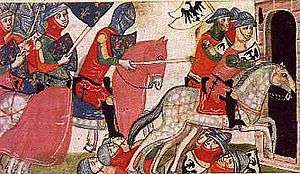Battle of Benevento
| Battle of Benevento | |||||||
|---|---|---|---|---|---|---|---|
 Battle of Benevento, from Giovanni Villani's Nuova Cronica | |||||||
| |||||||
| Belligerents | |||||||
| Guelphs (Angevin French and mercenaries) | Ghibellines (Kingdom of Sicily, German and Italian mercenaries) | ||||||
| Commanders and leaders | |||||||
| Charles of Anjou | Manfred of Sicily † | ||||||
| Strength | |||||||
|
4,600 cavalry Unknown number of infantry |
3,600 heavy cavalry 300 light cavalry 10,000 archers | ||||||
| Casualties and losses | |||||||
| Unknown |
more than 2,500 cavalry killed Unknown infantry | ||||||
The Battle of Benevento was fought on 26 February 1266 near Benevento, in present-day Southern Italy. It was waged between the troops of Charles of Anjou and Manfred of Sicily. Manfred's defeat and death resulted in the capture of the Kingdom of Sicily by Charles, effectively ending the rule of the Hohenstaufen in the Italian Peninsula.
Background
The Papacy had long been in conflict with the Imperial house of Hohenstaufen over their rule in Italy. At the time of the battle, the Hohenstaufen ruler in the Kingdom of Sicily (which included Sicily and southern Italy) was Manfred, illegitimate son of Frederick II, Holy Roman Emperor. While the rightful heir to the kingdom was Frederick's legitimate grandson Conradin, he was young and safely across the Alps in Bavaria. Taking advantage of a false rumor of Conradin's death, Manfred had usurped the throne in 1258. Pope Urban IV determined to wrench the Kingdom from him, and in 1263, concluded a secret treaty with Charles of Anjou, giving him the Sicilian throne.
Prelude
Charles reached Rome in 1265, but was temporarily halted by financial embarrassments. Manfred, however, did not take the field against him until January 1266, when Charles' main army had crossed the Alps. Alarmed by desertions among his followers and fearing further treachery, Manfred sought to bring Charles to battle as swiftly as possible. Charles attempted to turn Manfred's position at Capua by a perilous crossing of the Apennines which wrecked his supply line; but Manfred had intelligence of his move and lay in a strong position across the River Calore, crossed only by one bridge.
Charles had divided his cavalry into three "battles". The infantry and the first battle, consisting of 900 Provençals were at the front, commanded by Hugh of Mirepoix, Marshal of France, and Philip of Montfort, Lord of Castres.[1] Behind them were the second battle, which consisted of 400 Italians and 1,000 men of Languedoc and central France. Charles would command the second battle in person.[1] Behind them, the third battle consisted of about 700 men from the county of Flanders under Gilles II de Trasignies, Constable of France, and Robert III of Flanders.[1][2]
Manfred had adopted similar dispositions. His Saracen archers were in the fore.[3] Behind them was the first battle, 1,200 German mercenaries armed in coats of plates (a novelty at the time), commanded by his cousin Giordano d'Anglano and Galvano of Anglona.[3] The second battle consisted of the Italian mercenaries, about 1,000, and 300 Saracen light horse, commanded by his uncle Galvano Lancia.[3] The third battle, numbering 1,400, were the feudatories of the Kingdom, under Manfred's personal command.[3]
Battle
The battle began in the morning, when Manfred advanced his Saracens (archers and a few light cavalry) across the bridge to skirmish. They drove off Charles' infantry, but were put to flight by his Provençal cavalry.[1] Rashly, Manfred's first battle crossed the bridge and counter-charged.[1] At first, the German mercenaries seemed unstoppable; all blows rebounded from their armor plates, and Charles was forced to commit his second battle. The Germans continued to advance, but then the French discovered that the new plate armor did not protect the armpits when the arm was lifted to strike.[1] The Germans were swiftly broken.
The tide of battle now rapidly turned against Manfred. His troops were forced to defile across the single bridge over the Calore to reach the field. By the time his second battle had crossed the bridge, Charles had ordered his third battle to charge them on both flanks and they were swiftly destroyed.[4] Upon the defeat of the Italians, most of the nobles in Manfred's third battle deserted him, leaving only the king and a few faithful followers.[4] After exchanging the royal surcoat with his friend Tebaldo Annibaldi, Manfred and his followers charged into the fray and were slain.[4] The narrow bridge acted as a bottleneck, causing many to be killed or captured. Only 600 of the 3,600 horsemen escaped.[4]
Aftermath
The destruction of Manfred's army marked the collapse of Hohenstaufen rule in Italy. The remainder of the Kingdom of Sicily was conquered almost without resistance. Settled in his new kingdom, Charles could await the coming of Conradin, the last hope of the Hohenstaufen, in 1268, and meet him at the Battle of Tagliacozzo.
References
- 1 2 3 4 5 6 Steven Runciman, The Sicilian Vespers: A History of the Mediterranean World in the Later Thirteenth Century, (Cambridge University Press, 2000), 93.
- ↑ Gravett, Christopher and Turner, Graham. "German Medieval Armies: 1000-1300." Osprey Military Men-at-Arms 310. (Oxford: Osprey Military, 1997) p. 38
- 1 2 3 4 Steven Runciman, The Sicilian Vespers: A History of the Mediterranean World in the Later Thirteenth Century, 92.
- 1 2 3 4 Steven Runciman, The Sicilian Vespers: A History of the Mediterranean World in the Later Thirteenth Century, 94.
Sources
- Runciman, Steven (2000). The Sicilian Vespers. Cambridge University Press. ISBN 0-521-43774-1.
- Spaulding, Oliver Lyman and Hoffman Nickerson (1993). Ancient and Medieval Warfare. Barnes & Noble. ISBN 1-56619-241-2.
| Wikimedia Commons has media related to Battle of Benevento. |
Coordinates: 41°08′00″N 14°47′00″E / 41.1333°N 14.7833°E